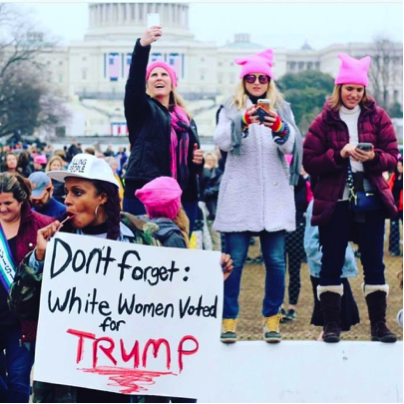by Cecilia Barreto, Aditi Joshi, Alexa Kasner, and Ixchel Lopez
The Women’s March on Washington, at its highest level was coordinated and led by women of color—many of whom are activists in their local communities. Women such as Linda Sarsour, a Muslim activist focuses her activism on the rise of Islamophobia in the United States. However, the march seemed to stray away from issues facing the most marginalized women in the U.S. and was ultimately co-opted by white women across America. As brown and black women marched, they were often silenced by the louder voices of white women throughout the protest. Women of color took to Twitter and Facebook to voice their own experiences at the march.
Hokte, an Indian woman, marched with a group of indigenous women and shared her experience of the Women’s March. On Twitter, Hokte stated that while in a sacred prayer circle with the other indigenous women, white women passed by and through their circle. They gazed and took photos of them without their permission. White women told the indigenous women that they “looked beautiful” because they were wearing their religious regalia. Yet when asked to listen to the hardships of being an Indian woman in America, most quickly left and refused to take any informational flyers. Here white women were in awe of an indigenous sacred prayer circle, not because they wanted to learn more about the participants’ culture, but because they thought it looked cool and “artsy” and could make a good photo for social media. Hokte could hear white women shouting “this is just the beginning” throughout the march, but all she could think about was how she and her ancestors have been marching their entire lives for justice in the land that was stolen from Native American tribes. Hokte conveys that the march was disappointing; what she experienced instead was a façade that sought to cover up the ignorance that comes with white privilege. Millions of women marched, yet millions went home the same day, and will not do anything nor say anything to assist in the lives of minorities in America, the lives that they shouted for all day at the march. This march was perfectly convenient for white women because it did not force them to look past the white privilege from which they have benefit. Indeed, stating that this is “just the beginning” is an example of ignorance. The feeling of the urgency of injustice is a feeling that many non-white women have felt constantly for years. It has been a way of life. This chant is almost a slap to the faces of those who have long suffered from white supremacy in America.
The narrative around much of the march constructed the “average marcher”: a white, cis-gendered, well-off woman. Many of the marchers wore pink pussy hats representing backlash to a comment that Trump made. While these were certainly relevant to news of the time, focusing the march around the female reproductive system inherently excludes any people who identify as women but who do not necessarily identify with having female genitalia. In bringing together women for this march, the marchers discounted racial, socioeconomic, ability, and non-gender binary differences. Intersectional feminism—the strongest form of the movement—was ignored. This space was not a safe one for those women who did not fully perform as white feminists do. Many of the women who showed up to the march were first-time marchers; that fact demonstrates the wide reach of Trump’s election. However, because of this, many marchers ignored the work done that has been done by women of color and trans women for years. It was simply invisible to them.
The women’s march was more of a performative space for white women than it was a space for the creation of actual change and real solidarity between hegemonic and marginalized communities. The chants were mainly about reproductive health and its regulations. Of course, these are important issues that affect many people in this country, but when these became the march’s overwhelming focus it became about the bodies of cis-gendered white women, and left the bodies of women of color, trans women, and low-income women out in the cold.

